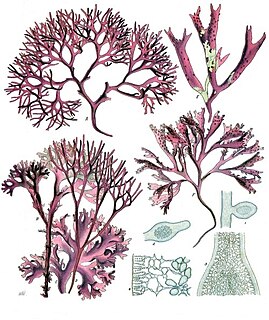
Chondrus crispus—commonly called Irish moss or carrageen moss —is a species of red algae which grows abundantly along the rocky parts of the Atlantic coast of Europe and North America. In its fresh condition this protist is soft and cartilaginous, varying in color from a greenish-yellow, through red, to a dark purple or purplish-brown. The principal constituent is a mucilaginous body, made of the polysaccharide carrageenan, which constitutes 55% of its dry weight. The organism also consists of nearly 10% dry weight protein and about 15% dry weight mineral matter, and is rich in iodine and sulfur. When softened in water it has a sea-like odour and because of the abundant cell wall polysaccharides it will form a jelly when boiled, containing from 20 to 100 times its weight of water.
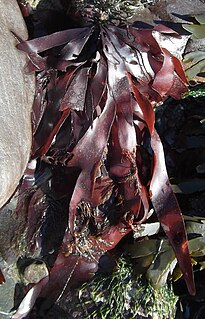
Palmaria palmata, also called dulse, dillisk or dilsk, red dulse, sea lettuce flakes, or creathnach, is a red alga (Rhodophyta) previously referred to as Rhodymenia palmata. It grows on the northern coasts of the Atlantic and Pacific Oceans. It is a well-known snack food. In Iceland, where it is known as söl[ˈsœːl̥], it has been an important source of dietary fiber throughout the centuries.

Porphyra is a genus of coldwater seaweeds that grow in cold, shallow seawater. More specifically, it belongs to red algae phylum of laver species, comprising approximately 70 species. It grows in the intertidal zone, typically between the upper intertidal zone and the splash zone in cold waters of temperate oceans. In East Asia, it is used to produce the sea vegetable products nori and gim. There are considered to be 60 to 70 species of Porphyra worldwide and seven around Britain and Ireland where it has been traditionally used to produce edible sea vegetables on the Irish Sea coast. The species Porphyra purpurea has one of the largest plastid genomes known, with 251 genes.

Mastocarpus stellatus, commonly known as carrageenan moss or false Irish moss, is a species in the Rhodophyceae division, a red algae seaweed division, and the Phyllophoracea family. M. stellatus is closely related to Irish Moss. It grows in the intertidal zone. It is most collected in North Atlantic regions such as Ireland and Scotland, together with Irish moss, dried, and sold for cooking and as the basis for a drink reputed to ward off colds and flu. Marine biologists have completed studies on the medicinal reputation of M. stellatus to discover the full potential of its pharmaceutical benefits. Additionally, marine biologists have conducted research on its potential to serve as an alternative to plastic. The application of M. stellatus in these different industries is correlated with the seaweed's adaptations which developed in response to the environmental stressors present around its location on the rocky intertidal.
Schmitzia hiscockiana is a small, rare, red seaweed or marine alga of the phylum Rhodophyta or red algae. It was discovered and named in 1985.

Polysiphonia is a genus of filamentous red algae with about 19 species on the coasts of the British Isles and about 200 species worldwide, including Crete in Greece, Antarctica and Greenland. Its members are known by a number of common names. It is in the order Ceramiales and family Rhodomelaceae.
Rhipiliopsis is a genus of green algae in the family Rhipiliaceae. Johnson-sea-linkia is a synonym.

Red algae, or Rhodophyta, are one of the oldest groups of eukaryotic algae. The Rhodophyta also comprises one of the largest phyla of algae, containing over 7,000 currently recognized species with taxonomic revisions ongoing. The majority of species (6,793) are found in the Florideophyceae (class), and mostly consist of multicellular, marine algae, including many notable seaweeds. Red algae are abundant in marine habitats but relatively rare in freshwaters. Approximately 5% of red algae species occur in freshwater, environments with greater concentrations found in warmer areas. Except for two coastal cave dwelling species in the asexual class Cyanidiophyceae, there are no terrestrial species, which may be due to an evolutionary bottleneck in which the last common ancestor lost about 25% of its core genes and much of its evolutionary plasticity.

Polysiphonia morrowii is a species of red algae native to Northeast Asia. It has become an invasive species in Europe, Australia, New Zealand, and South America.
Characium marinum is a species of green algae (Chlorophyta).

Pyropia tenera, also known as gim or nori, is a red algal species in the genus Pyropia. The specific name, tenera, means "delicate" and alludes to its small size. It typically grows to lengths between 20 and 50 cm. It is most typically found in the western Pacific Ocean and the Indian Ocean.

Endocladia muricata, commonly known as nailbrush seaweed or turfweed, is a marine alga that is widely distributed along the shores of the North Pacific Ocean, from Alaska to Punto Santo Tomas, Baja California.
Mastophora is a genus of thalloid alga comprising four species. The dimerous, crustose thalli comprise two groups of filaments. The bulk of the thallus is made of erect filaments, which may be one or many cells long. These grow approximately perpendicular to the filaments of a basal layer, usually one cell thick. haustoria, haustoria, and palisade cellsare present in the organisms but lack secondary pit connections. Mastophora reproduces by means of conceptacles; it produces tetraspores and dispores.
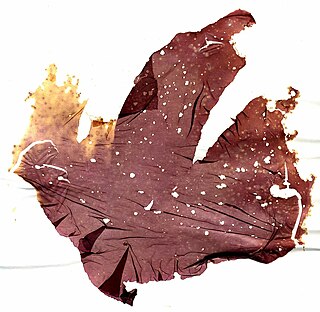
Porphyra purpurea is a medium sized marine algae in the Division Rhodophyta.
Pythium porphyrae, is a parasitic species of oomycete in the family Pythiaceae. It is the cause of red rot disease or red wasting disease, also called akagusare (赤ぐされ) in Japanese. The specific epithet porphyrae (πορφυρα) stems from the genus of one of its common hosts, Porphyra, and the purple-red color of the lesions on the thallus of the host. However, many of its hosts have been moved from the genus Porphyra to Pyropia.

Chondracanthus exasperatus, commonly called Turkish towel, is a species of seaweed in the family Gigartinaceae. The specific epithet exasperatus refers to the bumpy texture of the blades. This texture also leads to the common name which evokes the luxurious feel of a towel from a Turkish bath. The rough, papillae-strewn blade surface even makes it difficult to measure the temperature using infrared thermometers.
Lessonia trabeculata is a species of kelp, a brown alga in the genus Lessonia. It grows subtidally off the coasts of Peru and northern and central Chile, with the closely related Lessonia nigrescens tending to form a separate zone intertidally. Lessonia trabeculata kelp have gained a great economic importance for alginate production, and its harvest has greatly intensified along the Chilean coast during past two decades
Saccharina dentigera is a species of brown algae, in the family Laminariaceae. It is native to shallow water in the northeastern Pacific Ocean from the Gulf of Alaska to Baja California.
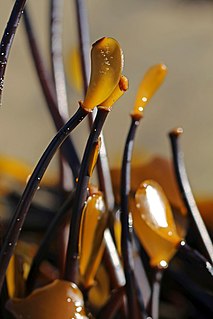
Laminaria sinclairii is a species of brown algae, in the family Laminariaceae. It is native to the lower intertidal zone of the northeastern Pacific Ocean from British Columbia southwards to California.
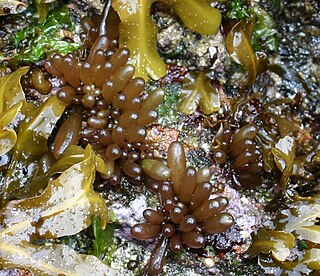
Halosaccion glandiforme, also known as sea sacs or sea grapes, is a species of red algae.













